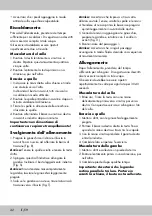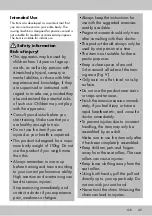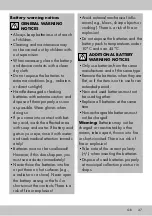
48
GB
Inserting batteries into the
rowing machine (fig. O)
CAUTION:
Observe the following
instructions to avoid mechanical
and electrical damage.
Insert the enclosed batteries (31) into the battery
compartment (10d) of the cockpit (10).
Inserting the batteries
1. Undo the screw on the battery compartment
cover (10c) on the back of the cockpit (10) and
remove the battery compartment cover (10c).
2. Carefully insert the 2 x 1.5 V batteries of type
D (31) into the battery compartment (10d).
The batteries must be completely fitted into the
battery compartment (10d).
CAUTION:
Check the plus/minus poles
of the batteries (31) and that they are in-
serted correctly, as marked on the bottom
of the battery compartment (10d).
3. Attach the battery compartment cover (10c) on
the back of the cockpit and tighten the screws
back in again.
Replacing the batteries
CAUTION: Observe the following
instructions to avoid mechanical
and electrical damage.
When the batteries (31) are no longer working,
replace them as described in the insertion instruc-
tions above.
Remove the batteries that are in the item before
inserting new ones.
Notes on setting up
• Choose an exercise area of approx.
3.00 x 1.80m (L x W).
• Train on a flat and non-slip surface only.
Assembly
The item should be assembled by two
people.
Step 1 (fig. C):
1. Attach the two front legs (7a), (7b) to the front
foot (3).
Note:
Make sure that the curved part on the two
legs (7a), (7b) are each turning outwards.
2. Then attach the two long legs (7a), (7b) to the
base frame (1).
Note:
To make it easier to assemble the legs,
turn the base frame so that the screw holes are
facing upwards.
Step 2 (fig. D):
1. Turn the slide rail (2) so that the screw holes are
facing upwards and mount the middle foot (9).
Note:
After completing the assembly of the
rowing machine, the floor height level can be
adjusted with the tommy screw.
2. Adjust the floor height levelling using the
toggle screw and then tightly secure the lock
nut (9a).
Step 3 (fig. E)
1. Leave the slide rail (2) in the inverted state and
mount the two footrests (6a), (6b).
Note
: Make sure the footrests are correctly
oriented (left (6a)/right (6b)).
Step 4 (fig. F):
1. Attach the two rear legs (8a), (8b) to the rear
foot (4).
Note:
Make sure that the curved part on the two
legs (8a), (8b) are each pointing outwards.
2. Slide the metal plate (15) into the slide rail (2)
and attach the rear legs (8a), (8b) to the slide
rail (2).
Note:
Make sure that the threaded holes on the
metal plate (15) are directly under the bores on
the slide rail (2).
Step 5 (fig. G):
1. Slide the saddle (5) from behind onto the slide
rail (2). To do this, direct the gliding carriage
under the seat into the guide on the slide rail.
Note:
Make sure the seat is correctly oriented.
2. Attach the stoppers (13) to the right and left on
the front and back end of the slide rail (2).
3. Insert the cover panel (14) onto the back end
of the slide rail (2).
Step 6 (fig. H):
1. Place the base frame (1) and the slide rail (2)
on the respective feet.
2. Connect the sensor cable (1a) of the base
frame (1) with the sensor cable (2a) of the slide
rail (2).
3. Insert the slide rail (2) in the base frame (1)
and screw it tight.
Содержание 292988
Страница 3: ...5 12 11 I 26 J 14 13b 13c 13b 13a 2 2 5 G 1a 2a 2 1 1 20 20 2 H ...
Страница 4: ...6 10 16 16 10a 10b 1b K 26 11 11 10 L M ...
Страница 5: ...7 1c N 31 10c 10d 10 O 10h 10e 10k 10l 10f 10g 10i 10j 10m 10n 10o P 1 6b 6a 2 Q ...
Страница 6: ...8 R S T ...
Страница 7: ...9 0 6m 0 6m 0 6m 0 6m V U ...
Страница 52: ...54 ...
Страница 53: ...55 ...
Страница 54: ...56 ...









































